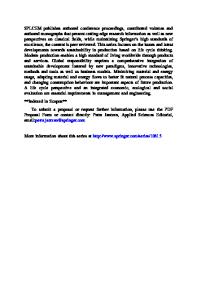Methyl siloxanes in road dust from a large silicone manufacturing site in China: implications of human exposure
- PDF / 942,000 Bytes
- 11 Pages / 595.276 x 790.866 pts Page_size
- 73 Downloads / 277 Views
RESEARCH ARTICLE
Methyl siloxanes in road dust from a large silicone manufacturing site in China: implications of human exposure Jiali Cheng 1 & Zhenwu Tang 2,3
&
Yan Ma 1 & Hongmin Yin 3 & Tong Meng 3 & Jiazheng Sun 3
Received: 30 June 2020 / Accepted: 19 November 2020 # Springer-Verlag GmbH Germany, part of Springer Nature 2020
Abstract Methyl siloxanes are becoming increasingly prevalent in the environment because of their extensive use in various consumer products. Little is known about the distribution of these chemicals around factories or their presence in road dust. We conducted a survey of four cyclic (D3–D6) and 13 linear (L4–L16) siloxanes in road dusts around a manufacturing site and found a total siloxane concentration range of 47.3–3.16 × 103 ng/g (median 372). The predominant siloxanes in the road dust samples were D3, D4, D5, and D6, with median contributions of 65.3%, 17.9%, 6.36%, and 2.16% of the total siloxane concentrations, respectively. Our reported concentrations were comparable to those found in household dusts in previous studies. No high concentrations of siloxanes were observed in the road dust samples from the manufacturing site, which suggests that siloxanes in outdoor dusts are likely affected by many factors. Under a high exposure scenario, the daily intakes of total siloxanes via road dust ingestion at the 95th percentile were 2.13 and 0.313 ng/kg-bw/day for children and adults, respectively. Although the estimated exposure to siloxanes in outdoor dust for humans was low, more studies on the distributions and risks of siloxanes released from manufacturing sites are needed. Keywords Methyl siloxane . Road dust . Manufacturing factory . Distribution . Human exposure
Introduction Methyl siloxanes are a class of organosilicon compounds containing Si-O-Si linkages and methyl branches (Hobson et al. 1997). These compounds are divided into cyclic (Dn) and linear (Ln) siloxanes, where n is the number of silicon atoms. Methyl siloxanes have been widely used in consumer products, including electronics, textiles, personal care products, and medical devices because of their lubricating
properties, high thermal stabilities, and low surface tensions (Kawamura et al. 2001; Lu et al. 2011; Wang et al. 2009; Zhang et al. 2012). Estimates put global production of siloxanes at 3.00 million tons in 2019 (IMARC 2019). China is a major producer of siloxanes worldwide with an annual yield that is estimated to increase from 1.02 to 1.50 million tons between 2017 and 2022 (CIIN 2018). According to information from the European Chemicals Agency, annual use of D4 in Europe ranges from 1.00 × 105 to 1.00 × 106 t and that of D5
Responsible Editor: Constantini Samara * Zhenwu Tang [email protected] Jiali Cheng [email protected] Yan Ma [email protected]
Jiazheng Sun [email protected]
1
National Institute for Nutrition and Health, Chinese Center for Disease Control and Prevention, Beijing 100050, China
2
College of Life and Environmental Sciences, Minzu University of China, Beijing 100081, Ch
Data Loading...










